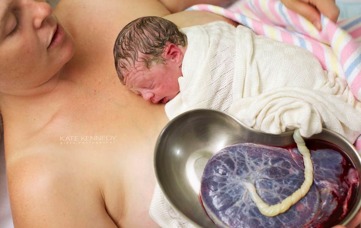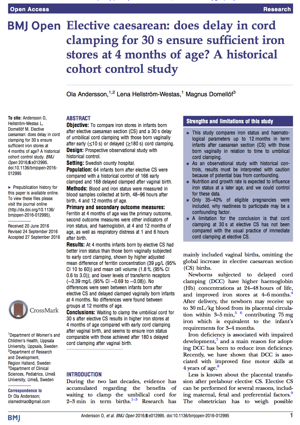2017 > 01
We have published 3 papers that provide evidence why umbilical cord clamping should be delayed for 3 minutes
In our latest study, published January 17th,
we randomized 540 children, born at a large obstetrical hospital in Kathmandu, Nepal, to early (≤ 60 seconds) or delayed cord clamping (≥180 seconds). In Nepal, approximately 70 % of infants up to one year of age have anemia. Follow-up included blood samples at 8 and 12 months of age, to evaluate anemia (hemoglobin) and iron deficiency (ferritin).
What did we find?
At the age of 8 months the incidence of anemia was reduced by 9% among the Nepalese infants and still at 12 months of age 8% fewer infants were anemic. The children in the delayed cord clamping group generally had higher hemoglobin values, and the percentage of children who had iron deficiency at 8 months of age decreased significantly, more than 40%.
Do you want a free Fact sheet on our latest study?
Click on the button below and sign up for our newsletter. Then you'll recieve a link for the fact sheet summorizing our findings concerning delayed cord clamping and anemia.
A delay of umbilical cord clamping by 30 seconds at elective cesarean section results in the similar iron stores as after 3 minutes delay of cord clamping in vaginally born infants, and provides better iron stores than immediate cord clamping in vaginally born infants.
In November 2nd, BMJ Open published our paper: 'Elective caesarean: does delay in cord clamping for 30 s ensure sufficient iron stores at 4 months of age? A historical cohort control study'
In this study we compared iron stores at 4 and 12 months of age in infants born after elective cesarean section with their umbilical cords clamped after 30 seconds with infants born vaginally and who either had their cord clamped immediately or after 3 minutes.
This was actually not what we had expected. Earlier research had implied that the placental transfusion after elective cesarean was rather small and should render similar iron stores as the immediately clamped vaginally born infants. This may likely be the case if the cord also is clamped immediately after CS. What was also quite surprising was that the placental transfusion seems to happen faster after CS than after vaginally birth, as 30 seconds after CS was comparable with 3 minutes after vaginally birth. This might be explained by the fact that babies born vaginally are under a normal strain and have higher blood pressure than babies after CS.
The paper can be read here: Andersson O, Hellström-Westas L, Domellöf M. Elective caesarean: does delay in cord clamping for 30 s ensure sufficient iron stores at 4 months of age? A historical cohort control study. BMJ Open 2016;6:e012995. doi: 10.1136/bmjopen-2016-012995
http://dx.doi.org/10.1136/bmjopen-2016-012995
LATEST POSTS
- Three Reasons To Wait To Clamp The Umbilical Cord
- Midwives in Sweden tends to clamp the umbilical cord in a way that is more natural and practical in…
- New uptodate review on cord clamping
- In memory of Hans Rosling:
- 3 reasons for clamping the umbilical cord after 3 minutes
- 30 seconds might be enough when delaying cord clamping at cesarean sections
- This years christmas gift to all babies
- Major break-through for delayed cord clamping
- 10 years today since this important paper was published
- Podcast about delayed cord clamping.
 0 comments
0 comments 





Israel Brown » Major break-through for delayed cord clamping: ”It is worth taking such a recommendation . However, cord milking in both preterm..”
Dr Robyn Thompson » Major break-through for delayed cord clamping: ”Midwives with women have not been practising early cord clamping for decades tha..”
Sally » Major break-through for delayed cord clamping: ”What's the number of babies needing photo therapy for term babies., talk about i..”
Tonia » Major break-through for delayed cord clamping: ”The picture in this article shows a placenta several minutes after delivery. The..”
Steve Kabamba » Major break-through for delayed cord clamping: ”What is the stand in the High burden HIV population? What is the risk of contrac..”